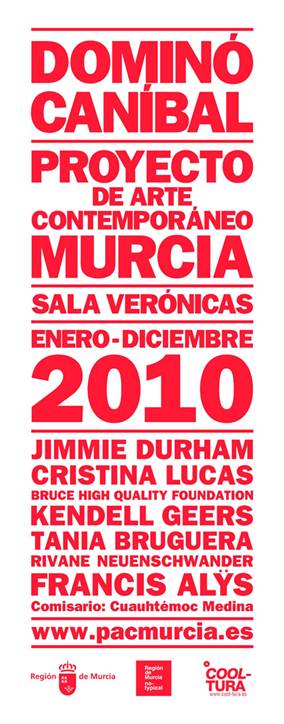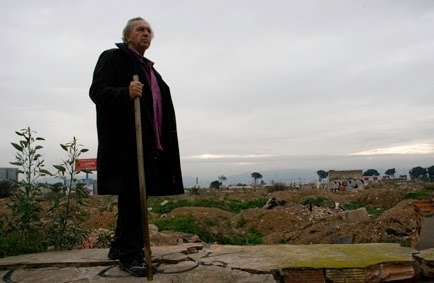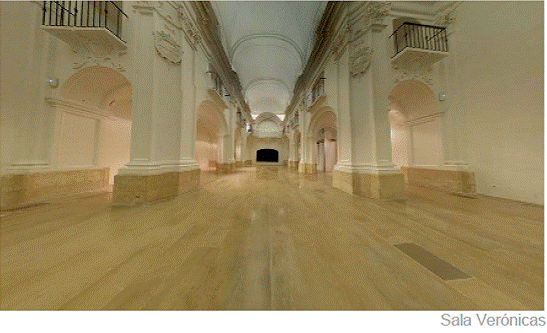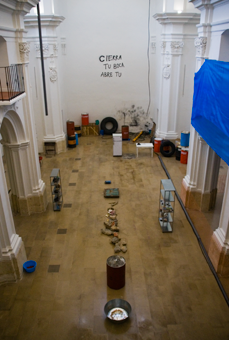Manifesta 9, "The Deep of the Modern", Genk, Belgium, 2 June – 30 September 2012 in pictures and seen by the critics
Tue, Jun 12 2012
Façade of the Waterschei industrial complex of the former coal mine in Genk where Manifesta 9 takes place.
Extra materials:
In her prologue Manifesta founding director Hedwig Fijen, defines the difference and the strength of the current incarnation of the European biennial: "'The Deep of the Modern'" is the first Manifesta biennial to intentionally leave behind its strictly contemporary origins as the basis of its exhibition model. As an uncompromising European contemporary art event, Manifesta 9 distances itself from the much-hyped model of showcasing only the latest artistic production by emerging talent, typical of these mega-shows. Instead it embarks on a critical attemps to foster interdisciplinary and intergenerational dialogue between the history of the site and the sometimes overlooked memories of the mining communities."
The introduction of an art historical perspective into the project has been a way to appeal to a more diverse audience, as Cuauhtémoc Medina, Chief Curator of Manifesta 9, has noted in his introductory essay: "our hope is that the long historical perspective will attact a local audience in a region that has not customarily been a consumer of contemporary art, along with a number of scholars and the descendants of the miners that built the region."

Art Agenda's review by writer and Co-Director of Tulips & Roses gallery in Brussels, Jonas Žakaitis provides the backstory:
"Genk is a town built for the sole purpose of getting the black stuff out of the ground. Early in the last century, after geologist André Dumont discovered significant amounts of coal lurking in the area, something like 60,000 people moved in from various parts of the world to work in and around the pits, building several large-scale mining complexes with the town's modest amenities sprinkled around them. When heavy industry glaciers started moving out of Western Europe in the 1980s, Genk was left with a large useless hole right in the gut. The remaining fraction of the Waterschei mine (23,000 sq. m of it) is an involuntary witness to this process of de-industrialization, a derelict but beautiful and proud building. After Manifesta 9, or so it tells me in the press pack, it "will be redeveloped as part of a master plan to create Thor park (is this name a jolly wink to the Germanic god of thunder, I wonder), a business and science complex focusing on innovation and knowledge."
Stairs connecting the first and second floor of the Waterschei.
Kate Sutton's Artforum.com review also framed the loaded context: "Chief curator Cuauhtémoc Medina, together with co-curators Katerina Gregos and Dawn Ades, selected the Belgian province of Limburg, “a mini European Union” also known as “Euregio-Meuse-Rhine.” The region has spent much of this century heavily dependent on coal production, but, with the last mine closing in 1992, Limburg is now eager to transition to new technology. Once a kind of Emerald City for coal miners, the garden city of Genk provides the ideal venue with its massive, Art Deco–style André Dumont mine."
Top floor of the Waterschei building.
As Javier Hontoria noted in his El Cultural review, Medina wanted to concentrate everything in the Waterschei, "favoring the concept of "exhibition" versus the "festival", and consequently emphasizing the metaphor of the vertical versus the horizontal to the light of new economic systems." (...) "The idea of strata" – he continues – "so tied to the world of mining, backbones the sense of the exhibition, which, under the title "The Deep of the Modern", unfolds in a concise and accurate way throughout the three levels of the building."
As explained in the press kit, 'The Deep of the Modern' begins with '17 Tons' "an exploration of the cultural
production that has been powered by the energy of memory that courses
through the diverse heirs of coal mining in the Campine region of
Limburg, as well as several other regions in Europe".
Models of the Underground from the 1950s, 3D representations used to teach 14–17 year old boys mining techniques and location of the coal layers.
Works by Manuel Durán (an 82 yeard old self-taught artist and former miner for 19 years) who has been making "Miners' heads" sculptures since the 1950s out of potato pulp, coal, salt and paint.
Lara Almarcegui, "Wasteland (Genk), 2004–16. More than 1 hectare of wasteland in public space." For the project, Almarcegui identified a neglected plot of land and scouted, surveyed and described the land. "Through negotiations iwth the City of Genk, Almarcegui arranged to protect the terrain from development for ten years (...). For Manifesta 9, the City of Genk agreed to extend the work for an additional two years and is currently in the planning stages of protecting it in perpetuity." (text by Steven Op de Beeck included in Manifesta 9 manual "The Deep of the Modern – A subcyclopaedia", Silvana Editoriale). Latitudes' visited the site back in 2007 (see blog here).
Continuing on the second floor we encounter 'The Age of Coal': "An art historical exhibition comprising
artworks from 1800 to the early 21st century about the history of art
production aesthetically related to the industrial era" (...) "organized into several thematic
sections with artworks in which coal played an important role. Coal as
the main fuel of industry, as a major factor of environmental change, as
a fossil with significant consequences in the field of natural science,
as the main referent of certain forms of working class culture and as a
material symbolic of the experience of modern life".
One of the three works by Marcel Broodthaers, "Trois tas de charbon", 1966-67.
David Hammons, "Chasing the Blue Train" (1989) "focuses on the powerpul metaphor of the railroads that have tgransformed the landscape and socity of the US since the 19th Century." (text by Mieke Mels in Manifesta's "The Deep of the Modern – A subcyclopaedia", Silvana Editoriale).
Richard Long's 26 meter long black "Bolivian Coal Line" carpet from 1992.
Rossella Biscotti, "Title One: The Taks of the Community", 2012. Biscotti also contributed with "A Conductor", 2012: On December 2009, the Unit 2 of the Ignalina Nuclear Poer Plant in Lithuania closed, consequently materials from the site were put up for auction. Biscotti acquired lead which have now been reused in Belgium into the new electrical wires to supply electricity for the show. She also acquired lead, which is the basis for her floor sculptures in the spectacular Sint-Barbara's hall.
Antonio Vega Macotela (below) Study of Exhaustion — The Equivalent of Silver (2011), "a
(failed) venture to export a “boleo” of coca leaves from Bolivian
silver mines represented by a boleo-shaped piece of silver, roughly the
amount of silver one miner gets out in a day" (Jonas Žakaitis in Art Agenda); and Rossella Biscotti (above).
Finally on the top floor, we find the section 'Poetics of Restructuring', with "contributions from 39 contemporary artists, focusing on aesthetic responses to the worldwide “economic restructuring” of the productive system in the early 21st century".
"This
archetypal kind of socio-econo-political development from
industrialization to de-industrialization to post-industrial
capitalism—and the corresponding forms of production, geographies, and
distributions of resources—is what Manifesta's contemporary art section,
mostly on the third floor of the building, is about." (Jonas Žakaitis in Art Agenda)
Manifesta educational materials and leaflets: "developed by the Manifesta 9 Education
& Mediation department. There are 3 different 3x3 Newspapers for 3 age groups (12-, 12+ and 18+), so make sure you have
the right one for you."
Ni Haifeng's "Para-Production", 2008-12 (ground floor) several tons of discarted fabric from trimmings originated in Chinese factories are re-sawn into a massive tapestry; and Bea Schilgelhoff's silk-screens "I'm too Christian for art" (2012) (top floor).
Ante Timmermans' "Make a Molehill out of a Mountain (of Work)" (2012), shelves full of packed A4′s to be manually perforated in his office space during the opening days to make a heap of confetti with the resulting paper, placed on a table at the opposite side of the room and overlooking the window that frames the also "perforated" mining mountain. This tiresome and repetitive administrative task concludes with stamping each of the perforated papers (with stamps designed by the artists) and filing them in binders placed in shelves.

Ante Timmermans' "Make a Molehill out of a Mountain (of Work)" (2012).
View of the landscape from Ante Timmermans' space and the remaining Waterschei building (not in use).
View of the landscape from Ante Timmermans' space and the remaining Waterschei building (not in use).
Goldin + Senneby's "The decapitation of Money", 2010. From the exhibition newspaper: "Goldin + Senneby and team test the hypothesis that Headless Ltd. (a mysterious offshore company registrered in the Bahamas) is a reincarnation of the secret society "Acéphale", founded by Georges Bataille and friends in 1936."
Emre Hüner, "A little Larger Than the Entire Universe", 2012.
Duncan Campbell's "Make It New John", 2009, 50' video. Depicting the "history of the DMC-12, the extravagant, futuristic automobile created by American engineer and entrepeneur John Delorean (1925-2005). Campbell documents the strange attempt to use its production as a tool of social engineering. Relying heavily on archival footage, and incoporating a few staged scenes that introduce a political and biographical allegory, Campbell attempts to construct a panoramic view of the polar extremes that have characterized the social life of this icon of consumerism." (text by Cuauhtémoc Medina in in Manifesta's "The Deep of the Modern – A subcyclopaedia", Silvana Editoriale)
Back to Žakaitis analysis: (...)
The weird part though is that all of these things, displayed in a
generic and anemic way, are fenced from Mijndepot Waterschei, a full-blown and fully functioning museum assembled by former miners themselves back in 2004. Be sure to go there
if you visit this Manifesta, and check out hundreds of mining tools,
helmets, saint statues, a small train, and a 1:1 scale model of a coal
shaft: great stuff that can get you really sooty.
Nicoline van Harskamp, "Yours in Solidarity", 2009–12. Video, audio and archive material.
Praneet Soi's slideshow "Kumartuli Printer, Notes on Labor Part 1", 2010, which "parsed out the gestures of a printer's hands as he interacts with an ancient pedal-operated press in Calcutta. As the operator feeds paper into his anachronistic machine, it spits out grainy, high contrast images of his own hands, immersed in labor" (text by Cuauhtémoc Medina in in Manifesta's "The Deep of the Modern – A subcyclopaedia", Silvana Editoriale).
Maarten Vanden Eynde, "Plastic Reef", 2008–12: a collection of melted down plastic trash collected while swirling in the Pacific Ocean. For more info see his comprehensive website.
As for the publication "The Deep of the Modern – A subcyclopaedia" (Edited by Silvana Editoriale), the curator writes that it has been "designed to suggest the complexity of meaning involved in the whole project as well as the richness of the individual elements themselves. (...) We have chosen to publish a book that breaks from the mould of conventional exhibition catalogues. We evoke the form of the encyclopaedia as a means of organising a whole made up of multiple unities (...). This Subcyclopaedia will thus serve as a record of the research process behind the biennial. (...) Our neologism is meant to suggest a comparison between the use of this reference book and the exhumation of modernity's underworld in the heritage, culture and history of coal mining.".
Despite this intention of "breaking the mould", the 320-page book does include the traditional institutional forewords (to be precise, four) and an introductory curatorial essay by Medina. Many other texts are disseminated throughout the publication, which is organised in alphabetical order A to Z, mixing concepts (starting with "Accumulation", ending with "Underground as Hell"), with artist texts by a network of over 30 writers, and essays by Gregos ("Poetics of Restructuring: On the question of production in the contemporary section of Manifesta 9") and Ades ("The Age of Coal: An Underground History of the Modern"), amongst other long form texts (by Medina himself, Svetlana Boym, as well as misfit entries such as "The Legacy of Manifesta" by Hedwig Fijen).
Manifesta 9 curator Cuauhtémoc Medina (purple shirt) giving a tour during the opening weekend.
These and more photos (93 total) on Latitudes' flickr.
All photos: Latitudes | www.lttds.org

This work is licensed under a Creative Commons Attribution-NonCommercial-NoDerivs 3.0 Unported License.

This work is licensed under a Creative Commons Attribution-NonCommercial-NoDerivs 3.0 Unported License.
Launch of the monograph 'Lara Almarcegui. Projects 1995–2010', edited by Latitudes at 'The Dutch Assembly', ARCOmadrid, 15 February, 19-20h
Tue, Feb 14 2012
Cover of the monograph edited by Latitudes. Photo: Latitudes.
Editor: Latitudes
Publisher & Design: Archive Books, Berlin
Texts: Cuauhtémoc Medina, Lars Bang Larsen and Latitudes
Format: 224 pages, colour, 21 x 27.5 cm. Black-and-white and colour illustrations. Flexicover, English.
ISBN: 978-88-95702-05-6
Published by Berlin-based Archive Books, 'Lara Almarcegui. Projects 1995–2010' is the first monograph presenting an overview of the last fifteen years of Almarcegui's artistic practice. The main part of the publication is formed by detailed documentation of the artist’s works and publications companioned by new descriptive texts written by the editors and the artist. These are presented in the following sections: ‘Demolition’, ‘Excavation’, ‘Construction materials’, ‘Ruins’, ‘Wastelands’ (survey, access, and preservation). (+ info...)
Lara Almarcegui (1972, Zaragoza. Lives and works in Rotterdam, the Netherlands) has had solo shows at Künstlerhaus Bremen, Bremen (2011); Centro Andaluz de Arte Contemporáneo, Sevilla (2011); TENT, Rotterdam (2011); Secession, Vienna (2010); Ludlow 38, New York (2010); the Centro Arte Contemporaneo, Málaga (2007), FRAC Bourgogne, Dijon (2004) and at INDEX, Stockholm (2003). She participated in group exhibitions such as Radical Nature – Art & Architecture for a Changing Planet 1969-2009, Barbican, London (2009); Taipei Art Biennial, Taiwan (2008); Estratos, Murcia (2008); Sharjah Art Biennial 8, Sharjah (2007); 27th São Paulo Bienal, São Paulo (2006); Frieze Art Fair Projects, London (2006) and the Liverpool Biennial (2004). In 2008 she presented the guidebook 'Ruins in the Netherlands XIX-XXI' published by Episode. Almarcegui studied Fine Arts in Cuenca (1991–95) and at the Ateliers 63, Amsterdam (1996–98). She has recently been awarded the Dolf Henkes Prize, Rotterdam (2011). In 2012 Almarcegui will have solo shows at the Centro de Arte Dos de Mayo, Móstoles and the Museo de Arte Contemporáneo de Castilla y León (MUSAC).
The publication has been possible thanks to the support of the former Fonds BKVB (Netherlands Foundation for Visual Arts, Design and Architecture), currently Mondriaan Fund.
All photos: Latitudes | www.lttds.org (except when noted otherwise in the photo caption)

This work is licensed under a Creative Commons Attribution-NonCommercial-NoDerivs 3.0 Unported License.
All photos: Latitudes | www.lttds.org (except when noted otherwise in the photo caption)

This work is licensed under a Creative Commons Attribution-NonCommercial-NoDerivs 3.0 Unported License.
Photos 'In conversation with Lara Almarcegui', 19 May 2011, TENT, Rotterdam
Mon, Jun 6 2011
'An evening with Lara Almarcegui', TENT Rotterdam, 2011. Photos: Aad Hoogendoorn.

On Thursday 19 May, Latitudes hosted an in conversation with Zaragoza-born, Rotterdam-based Lara Almarcegui in TENT, where she currently has a solo show (until 26 June).
Manifesta 9 curator, art historian and essayist for the catalogue, Cuauhtémoc Medina, also joined reading some of the passages of his essay 'Lara Almarcegui and the freedom of the unplanned' which will be included in the forthcoming monograph of the artist published by Archive Books and edited by Latitudes.





During the event Latitudes showed 60 images of Almarcegui's recent work, discussed her TENT exhibition, showed draft pages of the forthcoming publication and shared a selection of questions sent by curators, gallerist, artists, colleagues and collaborators of Almarcegui, giving an opportunity to revisit some of her projects produced since 1995.
These included questions from Bik van der Pol, Ellen de Bruijne, Claire Doherty, Eva González-Sancho, Lars Bang Larsen, Pablo León de la Barra, Francesco Manacorda, Markus Miessen, Eva Scharrer, Hans Schabus and Manuel Segade.






Thank you to those who joined us and to those who participated from afar with their questions.
Manifesta 9 curator, art historian and essayist for the catalogue, Cuauhtémoc Medina, also joined reading some of the passages of his essay 'Lara Almarcegui and the freedom of the unplanned' which will be included in the forthcoming monograph of the artist published by Archive Books and edited by Latitudes.





During the event Latitudes showed 60 images of Almarcegui's recent work, discussed her TENT exhibition, showed draft pages of the forthcoming publication and shared a selection of questions sent by curators, gallerist, artists, colleagues and collaborators of Almarcegui, giving an opportunity to revisit some of her projects produced since 1995.
These included questions from Bik van der Pol, Ellen de Bruijne, Claire Doherty, Eva González-Sancho, Lars Bang Larsen, Pablo León de la Barra, Francesco Manacorda, Markus Miessen, Eva Scharrer, Hans Schabus and Manuel Segade.






Thank you to those who joined us and to those who participated from afar with their questions.
19 May, 20h: 'An evening with Lara Almarcegui', TENT, Rotterdam
Thu, May 5 2011 Several guides by Lara Almarcegui. Photo: Latitudes | www.lttds.org
Several guides by Lara Almarcegui. Photo: Latitudes | www.lttds.orgOn the occasion of Lara Almarcegui's solo show at TENT, Rotterdam (opening tomorrow 6 May and on view until 26 June 2011), Latitudes' will host an in conversation on May 19 (20h) with the Spanish-born Rotterdam-based artist to discuss their long-term collaboration as well as the editing process of the forthcoming monograph 'Lara Almarcegui. Projects 1995-2010'. (+ info...)
Manifesta 9 curator, art historian and essayist for the catalogue, Cuauhtémoc Medina, will also participate reading some of the passages of his essay 'Lara Almarcegui and the freedom of the unplanned' during the evening.
During the event Latitudes will also bring forward a selection of questions posed by curators, gallerist, artists, colleagues and collaborators of Almarcegui, giving an opportunity to revisit some of her projects produced since 1995 – see photos event.
Title: 'Lara Almarcegui: Projects 1995–2010'
Editor: Latitudes
Publish & Design: Archive Books, Berlin
Texts: Cuauhtémoc Medina, Lars Bang Larsen and Latitudes
224 pages, colour, 21 x 27.5 cm. Black-and-white and colour illustrations. Flexicover, English.
Print run: 2,500 copies
ISBN: 978-88-95702-05-6
Release date: Fall 2011
Cover price: € 35
 Publication possible thanks to the support of the Fonds BKVB (Netherlands Foundation for Visual Arts, Design and Architecture).
Publication possible thanks to the support of the Fonds BKVB (Netherlands Foundation for Visual Arts, Design and Architecture).Editing the forthcoming publication 'Lara Almarcegui. Projects 1995–2010'
Fri, Mar 18 2011 Mock up of the publication cover.
Mock up of the publication cover.
We are currently in the process of editing the first and most comprehensive monograph to date of Lara Almarcegui's work produced in the last fifteen years. Although Almarcegui has made many small format guidebooks as integral parts of her projects, this will be the first monograph presenting an overview of all of her artistic practice.
The main part of the publication is formed by detailed documentation of the artist’s works and publications companioned by new descriptive texts written by the editors. These are presented in the following sections: ‘Demolition’, ‘Excavation’, ‘Construction materials’, ‘Ruins’, ‘Wastelands’ (survey, access, and preservation).
Alongside an introductory essay by the editors, art critic, curator and art historian Cuauhtémoc Medina and the theorist and curator Lars Bang Larsen contribute texts. Medina presents a revised and updated version of a previously unpublished essay entitled ‘The beauty of open space: Lara Almarcegui and the freedom of the unplanned’. The essay involves an analysis of the ‘aesthetic tautology’ of the 17th-century English garden – ‘a field turned into a garden which is made to seem like a field’ – and develops a context for Almarcegui’s work through a partial history of man’s ‘perfection’ of nature, and more especially the concept of nature as coincidental with the origin of industrial modernity. Lars Bang Larsen offers an interpretation of a single work from the artist’s ‘Construction materials’ series: 'Construction materials, City of São Paulo' (2006). Based on a talk given by the author at the Creative Time Summit: Revolutions in Public Space, New York, October 2009, Bang Larsen argues that “Almarcegui’s work equips us with the hubris to reconceive of the city and evaluate and re-organise it as a social space”.
The main part of the publication is formed by detailed documentation of the artist’s works and publications companioned by new descriptive texts written by the editors. These are presented in the following sections: ‘Demolition’, ‘Excavation’, ‘Construction materials’, ‘Ruins’, ‘Wastelands’ (survey, access, and preservation).
Alongside an introductory essay by the editors, art critic, curator and art historian Cuauhtémoc Medina and the theorist and curator Lars Bang Larsen contribute texts. Medina presents a revised and updated version of a previously unpublished essay entitled ‘The beauty of open space: Lara Almarcegui and the freedom of the unplanned’. The essay involves an analysis of the ‘aesthetic tautology’ of the 17th-century English garden – ‘a field turned into a garden which is made to seem like a field’ – and develops a context for Almarcegui’s work through a partial history of man’s ‘perfection’ of nature, and more especially the concept of nature as coincidental with the origin of industrial modernity. Lars Bang Larsen offers an interpretation of a single work from the artist’s ‘Construction materials’ series: 'Construction materials, City of São Paulo' (2006). Based on a talk given by the author at the Creative Time Summit: Revolutions in Public Space, New York, October 2009, Bang Larsen argues that “Almarcegui’s work equips us with the hubris to reconceive of the city and evaluate and re-organise it as a social space”.

Coinciding with Almarcegui's solo show at TENT, Rotterdam, Latitudes' will host an in conversation with the Spanish-born Rotterdam-based artist and discuss the process of editing the monograph. During the event, Latitudes will also bring forward a selection of questions posed to curators, gallerist, artists, colleagues and collaborators of Almarcegui, giving an opportunity to revisit some of her projects produced since 1995.
Title: 'Lara Almarcegui: Projects 1995–2010'
Editor: Latitudes
Publish & Design: Archive Books, Berlin
Texts: Cuauhtémoc Medina, Lars Bang Larsen and Latitudes
224 pages, colour, 21 x 27.5 cm. Black-and-white and colour illustrations. Flexicover, English.
Print run: 2,500 copies
ISBN: 978-88-95702-05-6
Release date: Spring/Summer 2011
Cover price: € 35

Publication possible thanks to the support of the Fonds BKVB (Netherlands Foundation for Visual Arts, Design and Architecture).
All photos: Latitudes | www.lttds.org
PAC Murcia 2010: 'Dominó Caníbal', a year-long 'cannibalistic' exhibition project
Tue, Jan 12 2010Jimmie Durham's exhibition will open on Monday 25th January, and will be preceded by a conversation between him and Cuauhtémoc Medina, curator of 'Dominó Caníbal', on Friday 22 January, 6pm at CENDEAC. Below images of the artist during his recent site visits to Murcia and surroundings.
As PAC 2010 curator Cuauhtémoc Medina has stated “my starting point is the operation of the game of dominoes, which is a very widespread transcultural point of production. (...) From the ideological use of the so-called “domino effect” brings to mind the terrors of the Cold War and beyond”. Here "the creative process depends on observation and interaction with the previous moves, instead of viewing itself as the production of some unique and conclusive image." (1)
The ongoing creative process taking place in Sala Verónicas will be filmed in real time and on view at the PAC MURCIA website (www.pacmurcia.es).
As with the previous PAC in 2008 (see Latitudes' posts here and here) a series of activities are running parallel to PAC 2010: a seminar organised in collaboration with CENDEAC (Centro de Documentación y Estudios Avanzados de Arte Contemporáneo), a programme of exhibitions in art galleries in the region and series residences for artists from Murcia in Europe and America.
Coinciding with this edition of PAC, the European Biennial for Contemporary Art Manifesta 8 will also take place in Murcia and open on October 1st . The event is curated by three collectives Alexandria Contemporary Art Forum (Egypt), Chamber of Public Secrets (Denmark, Italy, Lebanon) and Tranzit (Austria, Czech Republic, Hungary and Slovakia) (see Latitudes post here and here) with the "aim to engage with Europe’s present-day boundaries with Northern Africa and its interrelations with the Maghreb region." (2)
'Dominó Caníbal', January–December 2010, Sala Verónicas, Murcia
Artists: Jimmie Durham (January 22nd) Cristina Lucas (March 26th), Bruce High Quality
Foundation (May 21st), Kendell Geers (July 9th) Tania Bruguera (September 24th),
Rivane Neuenschwander (November 12th) and Francis Alÿs (December 17th).
Curator: Cuauhtémoc Medina
Project Management: Carlos Urroz
Production: PAC Murcia is an initiative of the Department of Education and Culture of the Región de Murcia through its Directorate General of Fine Art and Cultural Goods.
Organiser: Department of Culture & Tourism, Region of Murcia
Press & Communication: Urroz Proyectos, T + 34 915 648 856, info@urrozproyectos.com, www.urrozproyectos.com
Project website: www.pacmurcia.es
UPDATE - images of Jimmie Durham's installation. Photos: La Lobera
(1) Curatorial text, available on http://www.pacmurcia.es
(2) Manifesta website
Images: Graphic identity of 'Dominó Caníbal', portraits of Jimmie Durham during his site visits to Murcia and surroundings and interior of Sala Verónicas (Photos: La Lobera). Courtesy PAC Murcia 2010.
Latitudes en La Vanguardia artículo 'De profesión, Comisario'
Sat, Jan 2 2010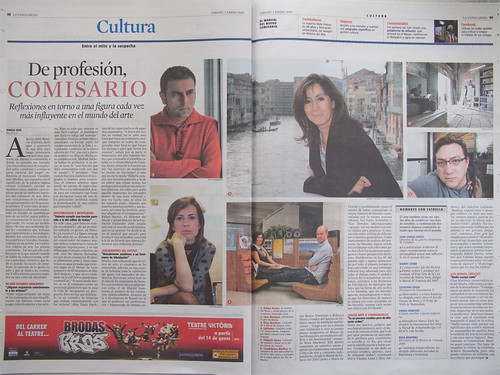
"Reflexiones entorno a una figura cada vez más influyente en el mundo del arte", artículo por Teresa Sesé, La Vanguardia, 2 Enero 2010, pp. 38-39. Incluye comentarios de Cuauhtémoc Medina, Tania Pardo, Valentín Roma, Rafael Doctor, Rosa Martínez, Latitudes (Max Andrews & Mariana Cánepa Luna) y Chus Martínez.
Latitudes' lecture 'Notes towards an ecology of risk' in 'Out of the Studio', Hasselt, Belgium
Mon, Nov 5 2007


 Last Sunday 28th October we spoke during the final session of out of the studio!
Last Sunday 28th October we spoke during the final session of out of the studio!The session included lectures by:
Cuauhtémoc Medina – Associated curator of art from Latin America, Tate Modern, London and researcher at the UNAM, Mexico. Lecture: “A different typology of public art in Latin America”
Max Andrews & Mariana Cánepa Luna – Founders of Latitudes, an independent curatorial office, Barcelona. Lecture: “Notes towards an ecology of risk”
Claire Doherty – Editor of 'Contemporary Art: From Studio to Situation' (2004), senior research fellow at the University of the West of England, Bristol. Lecture “Public Art as Situation: from temporary intervention to long-term commitment”
Closing remarks by: Frank Lubbers – Independent curator and art advisor, Brussels.



































